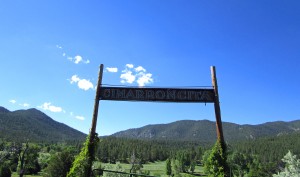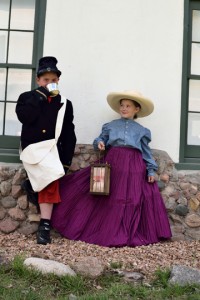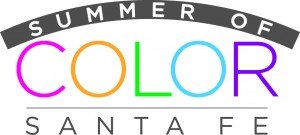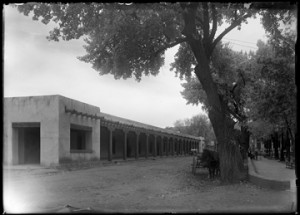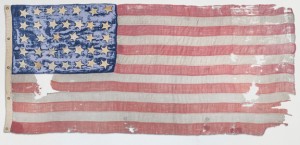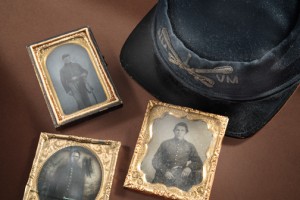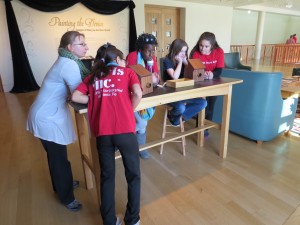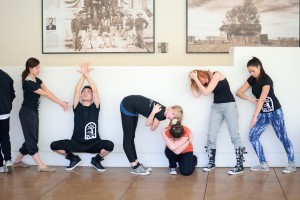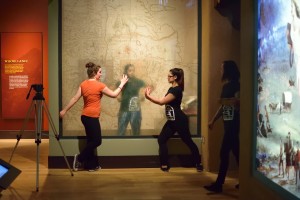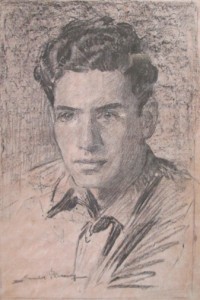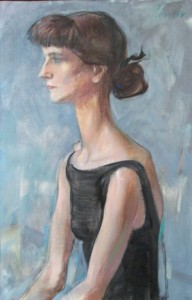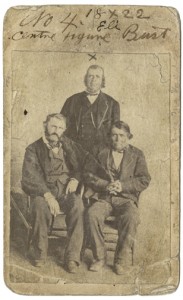 The Palace of the Governors Photo Archives has acquired a rare carte de visite depicting Ceran St. Vrain, Dick Wootton and José Maria Valdez. Photo Curator Daniel Kosharek obtained the ca. 1865 image from Cliff Mills, a photographer, collector and dealer who has sold his own and historical images on the Santa Fe Plaza for 20 years.
The Palace of the Governors Photo Archives has acquired a rare carte de visite depicting Ceran St. Vrain, Dick Wootton and José Maria Valdez. Photo Curator Daniel Kosharek obtained the ca. 1865 image from Cliff Mills, a photographer, collector and dealer who has sold his own and historical images on the Santa Fe Plaza for 20 years.
“I come from an old Taos family,” Mills said. “I’m pretty sure Valdez was a relative. This is a picture that came down to me through the family.”
Carte de visites were an early phenomena of photography. Mounted on cardstock, they could be given to friends or guests. That ease helped create a Victorian craze—“cardomania.” This particular carte de visite represents the first original photograph that the Photo Archives has of St. Vrain, a legendary frontiersman, military leader and wheat magnate. The museum has one small original photograph of “Uncle Dick” Wootton, and none of Valdez.
“This is very early for photography in New Mexico—very early,” Kosharek said. “So very little exists from that time period. It is rare when a photograph of historical significance on New Mexico becomes available.”
Mills considered offering the photo to a wider market, but chose the Photo Archives, he said, in part because “I like Daniel and Tomas” Jaehn, of the museum’s Fray Angélico Chávez History Library.
Brief bios on the men in the picture:
Ceran St. Vrain (1802-1870), standing in the center of the photo, was a frontier entrepreneur and close associate of Territorial Gov. Charles Bent and Kit Carson. In the 1820s, he traveled from St. Louis to Taos, becoming a trapper and trader. In the 1830s, his partnership with Bent blossomed. With Charles’ brother, William, the men built Bent’s Fort in Colorado, headquarters of a mercantile empire and an important stop for travelers on the Santa Fe Trail. In 1855 he was part of the “St Vrain’s battalion” during the Indian Wars and in 1861 was a Captain and later a Lt. Colonel in the New Mexico Volunteers. St. Vrain built the first grist mill in the Taos Valley and others in Mora, Santa Fe and Peralta. He became wealthy selling flour to the troops at Fort Union and Fort Craig. He also invested in sawmills, became involved in banking projects and railroad speculation, dabbled in politics and owned a share of The Santa Fe Gazette. He was buried at the Mora Presbyterian Church. His mill still stands in the town, though in an endangered condition.
Dick Wootton (1816-1893), seated at left in the photo, was also a frontiersman, born in Virginia, who hired out to Bent and St. Vrain at Independence, Mo., in 1836. He later gained infamy for building a toll road over Raton Pass and, for 13 years, charging travelers to use it.
José Maria Valdez, seated at right, was born in La Joya (now Velarde) in 1809. He married Maria Manuela Jaramillo in Taos in 1834 and was a witness at the wedding of his wife’s sister, Maria Josefa Jaramillo, when she married Kit Carson in 1843. (Another sister, Maria Ygnacia Jaramillo, married Charles Bent). He served in the Territorial Legislature and in 1859 was one of the petitioners for the Mora Land Grant.
The Palace of the Governors Photo Archives contains an estimated 1 million items, including historic photographic prints, cased photographs, glass plate negatives, film negatives, stereographs, photo postcards, panoramas, color transparencies, and lantern slides. This collection includes material of regional and national significance, dating from approximately 1850 to the present, covering subject matter that focuses on the history and people of New Mexico and the expansion of the West; anthropology, archaeology, and ethnology of Hispanic and Native American cultures; and smaller collections documenting Europe, Latin America, the Far East, Oceana, and the Middle East.
 Award-winning author and conservationist William deBuys speaks on and signs copies of his latest book and joins us for a reception honoring the museum’s acquisition of his papers. The Fray Angélico Chávez History Library hosts this free event on Friday, June 19, 5:30–7:30 pm, in the museum auditorium, with light refreshments in the lobby.
Award-winning author and conservationist William deBuys speaks on and signs copies of his latest book and joins us for a reception honoring the museum’s acquisition of his papers. The Fray Angélico Chávez History Library hosts this free event on Friday, June 19, 5:30–7:30 pm, in the museum auditorium, with light refreshments in the lobby.
